Fashion has many names that epitomize innovation, elegance, and sophistication. Yet, few designers boast a résumé as dynamic and impactful as Elsa Schiaparelli. Gather around, for the tale of a woman who was an alchemist in her own right—Elsa Schiaparelli.
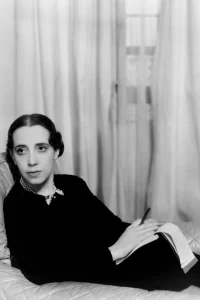
Born under the bewitching skies of Rome in 1890, this daring enchantress conjured a fashion revolution, turning the fabric of society inside out and stitching it back together with threads of surrealism, ingenuity, and fierce femininity. Elsa didn’t just break glass ceilings; she shattered them, creating a sky full of stars that we, her spiritual descendants, can still look up to.
Early Life and the Allure of Art
Elsa’s father was a dean of the University of Rome, and her mother came from a family of Arab scholars. With intellectualism running in her veins, young Elsa initially harbored an interest in philosophy and theosophy. However, her destiny called her toward a different sphere. Uncontrolled with a conventional academic path, Elsa moved to London to work as a nanny. This stint did not last long, but London introduced her to the world of bohemian art and avant-garde culture.
The Poet Phase

When Elsa moved to Paris, she didn’t immediately dive into fashion. Remarkably, she initially spent her time mingling with the Dadaists and experimenting with written words. Elsa took on the role of a poet and a writer, absorbing the artistic sensibilities around her. During her poet phase, she even published a collection of surrealist poems, but it wasn’t long before her artistic inclinations took another turn. Elsa met Paul Poiret, an already-established couturier who would become a critical figure in her life. Poiret sensed her untapped potential in fashion design and encouraged her to switch mediums. Energized by this new artistic avenue, she started designing clothes and launched her first collection in 1927. Elsa soon opened her boutique, which she aptly named “Pour le Sport.”
This phase of her life remains critical because it shows the multi-disciplinary nature of her talent. Her philosophy education met with a brief journey into Dadaism and poetry enriched her design philosophy and provided a more nuanced understanding of surrealism. In the end, it later profoundly influenced her fashion career.
The Surreal World of Elsa Schiaparelli
Paris in the 1920s and ’30s buzzed with artistic energy, especially in the surrealist circles. It was inevitable for Elsa to become friends with Salvador Dalí, Man Ray, and Jean Cocteau. Their influence on her designs became apparent almost immediately.
Elsa and Salvador Dalí

Elsa Schiaparelli’s friendship with Salvador Dalí wasn’t just a casual mingling of creative minds; it was a powerful collaboration that birthed iconic pieces. The duo worked closely to incorporate surrealism directly into fashion, dissolving the boundaries between art and attire. One of their most famous collaborations was the Lobster Dress, a silk organza gown featuring a large lobster painted by Dalí. Worn by Wallis Simpson, the American socialite, the dress became a sensation, signifying how fashion could provoke thought and stir conversation just like any surrealist painting.
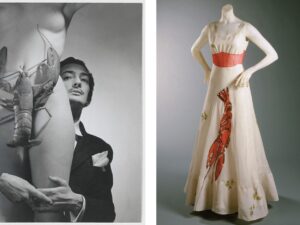
Another iconic piece they co-created was the Skeleton Dress, a fitted evening gown designed to mimic the human skeletal structure. The dress used trapped unto quilting to create padded ridges that resembled bones. The result was both unsettling and fascinating, the exact kind of reaction that both artists aimed to provoke.

The Birth of Shocking Pink
Elsa Schiaparelli did not limit her creative pursuits to clothing and she really did not need Dalí for creation. So, she delved into fragrances with the same fervor and imagination. When she set her sights on creating a perfume, she opted for a scent that embodied her personality—bold, audacious, and unapologetically vibrant.

The perfume, named “Shocking,” was born in 1937. It was housed in a bottle designed to replicate a curvy woman’s torso, complete with upswept breasts and a cinched waist. This body-shaped bottle preceded Jean Paul Gaultier’s similar designs for decades and marked a radical departure from the conventional perfume bottles of the time.
Femininity In A Glass
The bottle design of the Schiaparelli perfume Shocking! took inspiration from Mae West’s famous silhouette. Elsa had designed costumes for the American actress and was so intrigued by West’s voluptuous figure that she decided to immortalize it in glass. It wasn’t just an ordinary bottle; it was a work of art, capturing the essence of femininity and sensuality, much like the fragrance it contained.

The perfume, much like its creator and its bottle, was unforgettable. With its blend of exotic notes, “Shocking!” became a huge hit and was soon synonymous with the color Elsa loved so much—Shocking Pink. She even coordinated her packaging, advertisements, and branding to revolve around this signature hue, making the perfume an extension of her aesthetic.
The Surrealist Provocateur
She was an inventor in her own right. Elsa Schiaparelli’s first collection was a groundbreaking debut of fashion inventions. Take the Trompe-l’œil Sweater, for example. At a time when knitwear was considered casual and unremarkable, Elsa disrupted the status quo. Her sweater featured a ribbon and bow design that was knitted into the fabric, creating an optical illusion. The Trompe-l’œil Sweater made the cover of Vogue in 1927 and quickly gained popularity, offering women a playful yet sophisticated option.
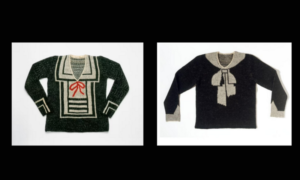
She also pioneered the skort—a hybrid of skirt and shorts. This garment gave women the freedom to engage in more physical activities without sacrificing style or decorum. By creating the skort, Elsa addressed practical needs while adding a fashionable twist, emblematic of her genius in merging function with form. She introduces us to the shoe hat and surrealist jewelry. Even the buttons of her designs were full of symbolism. Elsa was such a witch that she fell under the spell of every being in nature. So much so that she was the first female designer to design expensive jewelry from insects.

World War II and Beyond
The Second World War devastated Europe, including the fashion industry. The rise of Christian Dior and his “New Look,” which debuted in 1947, emphasizing traditional femininity and opulence, resonated with consumers seeking a return to pre-war norms.
This shift posed a challenge to Elsa’s avant-garde and surrealist styles appeared increasingly out of sync with mainstream preferences. The contrasting design philosophies of Dior and Elsa highlighted a growing divide in consumer taste, making it difficult for Elsa to maintain her earlier levels of success. Elsa was different, she was a witch, and her transverse designs starting to lose their power. Women are abandoning Elsa’s surreal fashion sense, preferring to be Dior’s “flower women”. In a way, they abandoned Elsa’s bugs to be a flower.
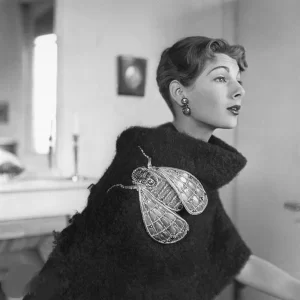
Despite continuing her work in American and South American markets during the war and resuming her Parisian operations post-war, Elsa faced commercial difficulties in the changing fashion environment. Ultimately, she made the hard decision to close her couture house in 1954.
Pioneering Ahead of Time
Long before Jean Paul Gaultier turned perfume bottles into sculptures of the human form, Elsa was already exploring the idea of a fragrance that was both a scent and a statement.
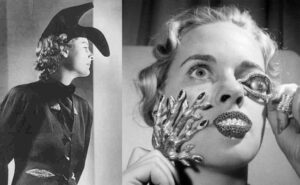
Through every creation, from costumes and dresses to perfume bottles and fragrances, Elsa Schiaparelli blurred the lines between art and utility, fashion and sculpture, all while keeping an indomitable spirit of innovation alive. Whether it was Mae West’s silhouette captured in a bottle or the aroma of Shocking Pink filling the air, Elsa proved that the only limit to fashion and fragrance was the scope of human imagination.
Legacy
Elsa Schiaparelli passed away in 1973, but her influence endures. Designers from Jean Paul Gaultier to Rei Kawakubo have cited her as an inspiration. In 2012, the Metropolitan Museum of Art in New York dedicated an exhibition to her work, further solidifying her status as a fashion legend.

Elsa Schiaparelli taught the world that fashion is more than just fabric and stitches; it’s a form of art, expression, and rebellion. And for that, her name will always resonate as one of the leading lights in the sartorial universe.
Referances:
- Britannica: “Elsa Schiaparelli“
- The Metropolitan Museum of Art: “Elsa Schiaparelli (1890–1973)”

